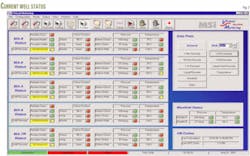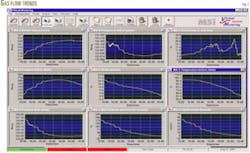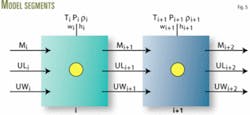Virtual system provides reliable multiphase metering from Malampaya wells
Paulo Picart, Shell Philippines Exploration BV, Manila
Sonny Llave, Multiphase Solutions Inc., Houston
Operational experience shows that virtual metering of multiphase flow from subsea wells in the Malampaya project, off the Philippines, has been cost-effective, accurate, and reliable in determining individual well production.
The Virtual Metering System (VMS), provided by Multiphase Solutions Inc. (MSi), Houston, has now almost 3 years of operational experience on Malampaya, since the field's first gas production in October 2001.
The system also controls methanol injection rates for hydrate inhibition as well as providing data for production reconciliation.
The only warning is that its continued effectiveness relies on the integrity and quality of the subsea instrumentation systems. Also, its effectiveness is linked directly to the market value of the produced condensate, which can be severely affected by the level of methanol contamination.
Malampaya
Shell Philippines Exploration BV (SPEX) implemented on its Malampaya platform a real-time, online software package to provide accurate estimates of multiphase flow rates from individual subsea wells based on an extensive set of measured production variables continuously provided by the platform's process automation system (PAS).
The system on the platform meters all production in bulk because no physical metering of production exists at individual Malampaya wells.
The Malampaya field is about 80 km off the coast of Palawan Island and is part of the Malampaya deepwater gas-to-power project that delivers gas from five subsea wells completed in 820 m of water to a shallow-water production platform in 43-m water for processing. Two 30-km flowlines tie the manifold serving the wellheads to the concrete gravity production platform. Besides the processing facilities on the topsides, the platform has a concrete base that stores stabilized condensate before it is loaded on shuttle tankers.
The dried gas from the platform moves through a 504-km subsea pipeline to an onshore gas plant in Batangas, Luzon Island, where the gas is further processed before being delivered to three combined-cycle gas turbine power plants (OGJ Jan. 7, 2002, p. 58).
Virtual metering
Virtual-metering software estimates wellhead flow rates based on parameters normally measured in and around the well.
On Malampaya, these well flow rate predictions are an integral component of the automatic subsea methanol injection system for hydrate inhibition (Fig. 1).
The control of methanol is directly linked to the market value of the produced condensate because the value of the condensate can be severely affected by the level of methanol contamination.
The software also provides a means for allocating production to each well, which is an important factor for monitoring reservoir depletion.
MSi has designed the system for unattended operation, with quarterly tuning, for the entire field life.
The system automatically receives process data and returns gas and liquid flow rate estimates and alarm information.
Although the software workstation is offshore, SPEX engineering offices can remotely access the system for tuning and monitoring.
Field accuracy, reliability
The virtual metering software design is robust, flexible, cost-effective, and a more-reliable alternative to actual physical metering.
In the case of Malampaya, virtual metering reduces cost, complexity, and leak paths in an extremely critical subsea system.
An equivalent installation of five subsea multiphase flowmeters (one per well) would have cost about 10 times more than the virtual metering system, not to mention the unproven reliability in deepwater service and lack of flexibility for future wells.
Future wet-gas meters may lower cost and improve reliability, but during the project execution phase, these meters were not ready. An additional advantage compared to Venturi-type meters is that the virtual meter can handle a much wider range of gas volume fractions. This is useful particularly in deepwater where one cannot easily reconfigure sensors as reservoir pressure depletes.
SPEX worked with MSi to validate the virtual software's full life-cycle predictions, against TRAFLOW and OLGA models. The study found that the virtual meter predictions were accurate to within 2-5% for a range of normal operating conditions and within 10% for cases where several instruments are lost.
An exception is at very low flow rates or system pressure drops where the model sometimes tends to under-predict.
In general, the metering errors for any system will depend on both the quantity and quality of the instrumentation. For Malampaya, with built-in redundancy of instruments at the well and subsea systems taken into account, the virtual predictions generally have compared to within 5-8% against daily platform measurements and monthly production reconciliation, against a design specification of 10%.
A case in point is that despite the total loss of downhole gauges on one subsea well, the use of other subsea instruments allows the virtual predictions to remain within the prescribed accuracy.
Information traffic
MSi based the virtual meter package on its standard distributed-component architecture (DCA), operating under a client-server environment, with the virtual-meter software scanning the PAS for key measurements, including but not limited to:
- Measured bottomhole pressure and temperature.
- Measured pressure and temperature before and after the subsea choke.
- Measured subsea manifold pressure and temperature.
- Measured subsea choke, wing valve, and master valve position.
Real-time estimates and trend plots are then given for:
- Gas and liquid flow rates.
- Uncertainty in the flow rate estimates.
- Well profiles (mass rates, temperatures, pressures, densities, and quality).
- Possible water production indication.
- Possible problems with the well and reliability of data.
Fig. 2 shows a screenshot of Malampaya virtual-meter current well status screen, and Fig. 3 shows the gas flow rate trend plots.
Modeling
The key to accurate flow rate estimation is the use of multiple modeling techniques. Some approaches are more accurate in some flow rate regions than others.
For example, the choke model is usually the best method for determining flow rate when the choke opening is small and the pressure drop across the choke is high. At these conditions (except late in field life), the flow usually is critical and the flow rate simply depends on the choke position and the upstream pressure.
As the choke opening increases and the pressure drop across the choke decreases, the choke model becomes increasingly sensitive to measurement error while the well tubing model becomes more accurate because of the increased pressure drop across the wellbore and decreased liquid holdup. An accurate prediction of the liquid holdup is important because the hydrostatic contribution can approach 90% of the total pressure drop in some cases.
A transient model is important because the liquid holdup depends on the production history. With Malampaya's varying gas offtake profile, the liquid holdup normally is not completely at steady state because it is continually accumulating or depleting.
The virtual metering system uses several predictive models to estimate flow rate. It looks at fluid flow models through several combinations of key sections of the system, for example, the reservoir, bottomhole, choke, manifold, and jumper. It assesses the uncertainty of each flow rate estimate and then combines the flow rate estimates to obtain the lowest overall uncertainty (Fig. 3).
Fig. 4. is a screenshot of the forecast page showing measured-vs.-calculated flow rates, including the calculated uncertainty for each flow model.
The virtual meter also includes a reservoir tank model to provide better estimates for a longer period of time by automatically accounting for reservoir depletion. Although the current depletion rate is roughly 1 bar/month, the tank model will become more important later in life when the depletion rate increases.
Tuning
Over time, the behavior of each well can change because of production composition changes, or the tubing can become rougher because of erosion or corrosion. In addition, the flowing tubinghead pressure will decrease as the well depletes and the choke wears.
For this reason, MSi on an ongoing remote support service tunes the virtual model on a regular basis through rigorous simulation work using historical production and reservoir data. A key area for improvement in the Malampaya system is a means for automatic tuning such that remote support is minimized.
As instrumentation behavior changes or fluid characteristics changes, MSi will tune the software to account for these and other time induced changes that affect key properties such as gas density and heat-transfer coefficients. Also noticed will be any unusual historical process behavior, communication changes, system changes, and equipment changes that may have a significant impact on modeling results.
The system calculates an uncertainty in each of the flow rate estimates made and uses them as weightings to determine a best estimate of the flow rate. One can supplement this approach by changing the weightings. The default weight is 1, while a zero can be set to ignore a particular flow estimate or a maximum of 10 can be set to make this particular flow estimate a predominant one.
Modeling engines
The virtual metering system employs a comprehensive error checking, data validation, and reconciliation protocol. This is a critical step for crosschecking each sensor measurement against other measured and predicted values to determine the correct input for the flow modeling.
MSi employs two of its field-proven modeling engines in the system. The first is a dynamic multiphase modeling engine called PIMS (pipeline integrity management system) for the well flow model. Its strength lies in its fast run-times while maintaining computational stability needed for high availability operations.
MSi based its PIMS model on numerically solving the governing equations by discretizing the well into a finite number of computational segments (Fig. 5).
The second modeling engine is a thermophysical fluid properties simulator called GUTS (grand unified thermodynamics simulator) developed and validated as part of a joint industry project (JIP) for a group of North Sea and Gulf of Mexico oil companies.
The authors
Paulo Picart was the principal process engineer for Malampaya for the past 2 years, focusing on mercury/ methanol-in-condensate, dynamic multiphase flow, system commissioning and debottlenecking, and environmental performance. His previous experience includes project engineering during the Malampaya execution phase and process engineering at Shell EXPRO. He currently is with Shell Malaysia's integrated development team in Miri, Malaysia. Picart has a BS in mechanical engineering from the University of the Philippines.
Sonny M. Llave is general manager of marketing and business development for Multiphase Solutions Inc., Houston. He has more than 18 years of experience in the petroleum industry, particularly in the upstream sector as principal engineer, project manager, and business development professional. Llave has a BS in chemical engineering and a BS in industrial and management engineering from De La Salle University, Manila, and an MS and a PhD in chemical engineering from the University of Notre Dame, South Bend, Ind.







